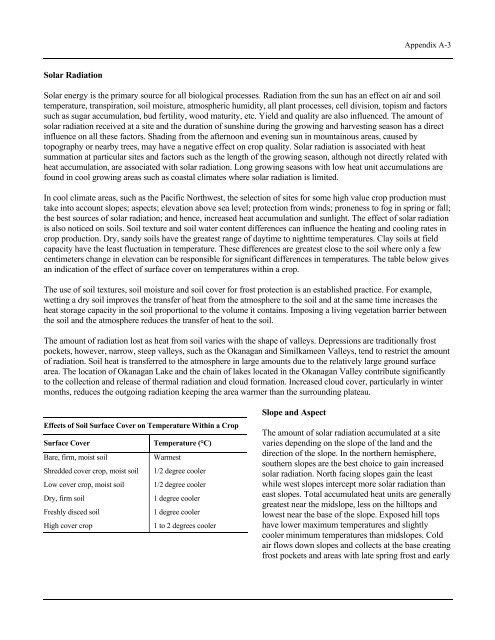Soil Management Handbook - Ministry of Agriculture and Lands
Soil Management Handbook - Ministry of Agriculture and Lands
Soil Management Handbook - Ministry of Agriculture and Lands
Create successful ePaper yourself
Turn your PDF publications into a flip-book with our unique Google optimized e-Paper software.
Solar Radiation<br />
Solar energy is the primary source for all biological processes. Radiation from the sun has an effect on air <strong>and</strong> soil<br />
temperature, transpiration, soil moisture, atmospheric humidity, all plant processes, cell division, topism <strong>and</strong> factors<br />
such as sugar accumulation, bud fertility, wood maturity, etc. Yield <strong>and</strong> quality are also influenced. The amount <strong>of</strong><br />
solar radiation received at a site <strong>and</strong> the duration <strong>of</strong> sunshine during the growing <strong>and</strong> harvesting season has a direct<br />
influence on all these factors. Shading from the afternoon <strong>and</strong> evening sun in mountainous areas, caused by<br />
topography or nearby trees, may have a negative effect on crop quality. Solar radiation is associated with heat<br />
summation at particular sites <strong>and</strong> factors such as the length <strong>of</strong> the growing season, although not directly related with<br />
heat accumulation, are associated with solar radiation. Long growing seasons with low heat unit accumulations are<br />
found in cool growing areas such as coastal climates where solar radiation is limited.<br />
In cool climate areas, such as the Pacific Northwest, the selection <strong>of</strong> sites for some high value crop production must<br />
take into account slopes; aspects; elevation above sea level; protection from winds; proneness to fog in spring or fall;<br />
the best sources <strong>of</strong> solar radiation; <strong>and</strong> hence, increased heat accumulation <strong>and</strong> sunlight. The effect <strong>of</strong> solar radiation<br />
is also noticed on soils. <strong>Soil</strong> texture <strong>and</strong> soil water content differences can influence the heating <strong>and</strong> cooling rates in<br />
crop production. Dry, s<strong>and</strong>y soils have the greatest range <strong>of</strong> daytime to nighttime temperatures. Clay soils at field<br />
capacity have the least fluctuation in temperature. These differences are greatest close to the soil where only a few<br />
centimeters change in elevation can be responsible for significant differences in temperatures. The table below gives<br />
an indication <strong>of</strong> the effect <strong>of</strong> surface cover on temperatures within a crop.<br />
The use <strong>of</strong> soil textures, soil moisture <strong>and</strong> soil cover for frost protection is an established practice. For example,<br />
wetting a dry soil improves the transfer <strong>of</strong> heat from the atmosphere to the soil <strong>and</strong> at the same time increases the<br />
heat storage capacity in the soil proportional to the volume it contains. Imposing a living vegetation barrier between<br />
the soil <strong>and</strong> the atmosphere reduces the transfer <strong>of</strong> heat to the soil.<br />
The amount <strong>of</strong> radiation lost as heat from soil varies with the shape <strong>of</strong> valleys. Depressions are traditionally frost<br />
pockets, however, narrow, steep valleys, such as the Okanagan <strong>and</strong> Similkameen Valleys, tend to restrict the amount<br />
<strong>of</strong> radiation. <strong>Soil</strong> heat is transferred to the atmosphere in large amounts due to the relatively large ground surface<br />
area. The location <strong>of</strong> Okanagan Lake <strong>and</strong> the chain <strong>of</strong> lakes located in the Okanagan Valley contribute significantly<br />
to the collection <strong>and</strong> release <strong>of</strong> thermal radiation <strong>and</strong> cloud formation. Increased cloud cover, particularly in winter<br />
months, reduces the outgoing radiation keeping the area warmer than the surrounding plateau.<br />
Effects <strong>of</strong> <strong>Soil</strong> Surface Cover on Temperature Within a Crop<br />
Surface Cover Temperature (°C)<br />
Bare, firm, moist soil Warmest<br />
Shredded cover crop, moist soil 1/2 degree cooler<br />
Low cover crop, moist soil 1/2 degree cooler<br />
Dry, firm soil 1 degree cooler<br />
Freshly disced soil 1 degree cooler<br />
High cover crop 1 to 2 degrees cooler<br />
Slope <strong>and</strong> Aspect<br />
Appendix A-3<br />
The amount <strong>of</strong> solar radiation accumulated at a site<br />
varies depending on the slope <strong>of</strong> the l<strong>and</strong> <strong>and</strong> the<br />
direction <strong>of</strong> the slope. In the northern hemisphere,<br />
southern slopes are the best choice to gain increased<br />
solar radiation. North facing slopes gain the least<br />
while west slopes intercept more solar radiation than<br />
east slopes. Total accumulated heat units are generally<br />
greatest near the midslope, less on the hilltops <strong>and</strong><br />
lowest near the base <strong>of</strong> the slope. Exposed hill tops<br />
have lower maximum temperatures <strong>and</strong> slightly<br />
cooler minimum temperatures than midslopes. Cold<br />
air flows down slopes <strong>and</strong> collects at the base creating<br />
frost pockets <strong>and</strong> areas with late spring frost <strong>and</strong> early
















